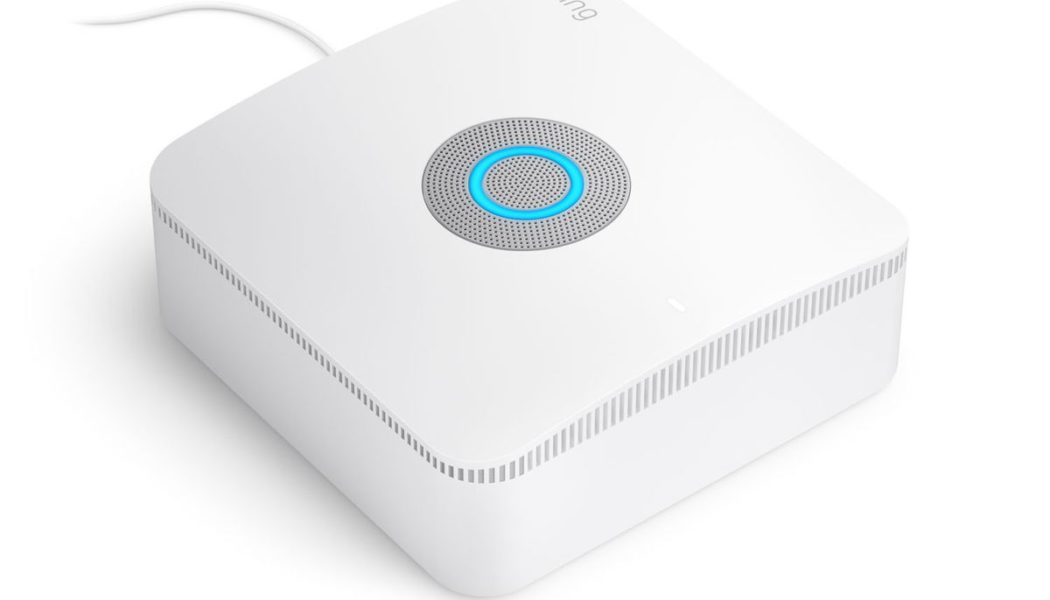Smart home company Ring has announced the third generation of its popular budget Ring Alarm home security product. The Ring Alarm Pro is a single device combining Ring’s security system with an Eero Wi-Fi router, 24/7 internet backup, and local processing and storage for Ring cameras.
This all-in-one device is designed to offer physical home security as the base station for Ring Alarm’s Z-wave sensors and digital security through the cybersecurity features Eero offers in its Wi-Fi system. It also acts as a smart home hub for compatible third-party gadgets, such as door locks, thermostats, and smoke alarms. And, with a new processor on board, the Ring Alarm Pro can connect to Ring cameras to process and store videos locally.
:no_upscale()/cdn.vox-cdn.com/uploads/chorus_asset/file/22881783/20210414_image_device_alarmprobasestation_wht_tabletop_angled_1500x1500_rgb.jpg)
The Ring Alarm Pro costs $249.99 for just the base station or $299.99 for an eight-piece security kit including contact sensors, a motion detector, a keypad, and a Z-wave range extender. Ring claims you will be able to swap out an existing Ring Alarm Base station without having to reconnect all your devices, and pre-orders start today in the US only, with shipping beginning November 3rd. The second-generation Ring Alarm is sticking around at $199 for a five-piece kit for those who don’t need these new features.
Along with the new hardware come new subscription packages. A new Ring Protect Pro subscription for $20 a month (or $200 a year) is designed to use with the new Ring Alarm Pro. This is a new level of Ring Protect that includes the local storage feature, a new 24/7 backup internet option, and an Eero Secure subscription, in addition to the cloud storage, professional monitoring, and Alexa Guard Plus that is part of the existing Ring Protect plan.
Ring also announced a portable version of Ring Alarm Pro designed for job sites, such as construction sites. The system leverages the cellular connectivity and Eero Wi-Fi capabilities to keep cameras and sensors online in places where you might not have internet up and running yet. It can be set up at one site and then dismantled, packed in a specially designed case and taken to the next job. The Ring Jobsite Security Kit starts at $399.99 and can be pre-ordered at HomeDepot.com.
This consolidation of services for your home — security and internet connectivity — is a smart move by Amazon, the parent company of both Ring and Eero. And it is notable as the first time Amazon has brought two of its smart home brands together into one piece of hardware. “This is really the first time we’ve all rolled up our sleeves and developed a product together,” Nick Weaver, CEO, and co-founder of Eero, told The Verge. “Simplifying and converging things makes a lot of sense.”
For Ring, the move was designed around providing security for the digital side of our lives, as well as the physical. “Historically, we’ve been focused on the physical security of our neighbors (customers),” explained Jamie Siminoff, founder of Ring. “But we’ve seen over the last few years how so many things have moved to digital — everything from money to pictures. We felt that, as a company whose mission is to make your neighborhood safe, just securing the physical things was no longer enough; we had to add the digital as well.”
There is a lot going on with this product. And while the words “smart home hub” were conspicuously absent from the pre-announcement conversations I had with Ring and Eero on the Ring Alarm Pro, this is a white plastic box packed with smart home communication protocols that lets your devices talk to each other. Its specs include two Ethernet ports, Bluetooth for setup, a Z-wave radio, 2.4 GHz and 5Ghz Wi-Fi, Wi-Fi 6, LTE, and a 902-928 MHz Radio (it’s Sidewalk-ready, but it’s not turned on). So, yeah, it’s a smart home hub — and a powerful one at that, although somewhat hampered by being firmly locked into the Ring / Amazon Alexa ecosystem.
The headline feature here is the built-in Eero router, as this is the first time Eero has put its TrueMesh technology in any non-Eero branded device. It’s not the first time we’ve seen a router in a smart home hub (Samsung’s Connect Smart Wi-Fi system combined mesh Wi-Fi with a SmartThings Hub). Still, the idea of merging a router and smart home / security hub helps simplify things for many everyday consumers — the clear target audience for Ring and Eero here.
Case in point, the Eero inside the Ring Alarm Pro is an Eero 6, not the more advanced Eero Pro 6. It’s capable of speeds up to 900Mbps over 1,500 square feet, but those speeds drop to around 500Mbps if you add more Eero nodes to create a mesh. The Pro offers gigabit speeds throughout the network, and while you can add Pro nodes to the Ring Alarm Pro network, the Eero in the Alarm Pro will need to be the main gateway connected to your ISP. “But if you’re getting less than 500Mbps [from your ISP], there’s really no benefit to having the Pro 6,” Weaver explained. “Unless you have a lot of devices on your network.”
From a security perspective, the Eero Secure service included in the $20 a month Ring Protect Pro Plan adds a layer of digital security to your network. “With Eero Secure, we’re basically ensuring that all the devices on your home network are staying safe and secure. So, you know, it blocks different attacks, helps you enable parental controls, and protects you from phishing,” said Weaver.
As an alarm system, the Ring Alarm base station does everything the previous generation does. It can connect to Ring’s sensors and compatible third-party Z-wave devices to monitor your home for intrusion, water leaks, and fire — and send emergency police, fire and medical response in the event of an incident if you pay for 24/7 professional monitoring.
The most significant change on the Ring side is that the new base station can now be a hub for Ring’s cameras. A new processor in the device enables local processing of videos from Ring cameras — including Ring’s new computer vision event-based alerts. The new service is called Ring Edge. “With local processing, we can do edge-based computer vision processing,” explained Mike Harris, COO of Ring. “We’ve got a whole ton of ideas that we want to put this thing to work for.” Edge-based processing means the data is processed locally rather than being sent to the cloud, helping increase speed and privacy.
:no_upscale()/cdn.vox-cdn.com/uploads/chorus_asset/file/22881786/20210621_us_lifestyle_insitu_alarmpro_secuirtysystem_livingroom_rgb_16x9.jpg)
Ring Edge also enables local storage of video through a removable microSD card (a 64GB that can hold around 47 hours of clips is included; you can use cards up to 512GB). It is part of the $20 per month Ring Protect Pro plan, so it’s not a workaround to avoid paying a monthly fee to view your camera feeds. However, it can help take the pressure off your bandwidth, and you can pick and choose which of your cameras stay local and which use the cloud to store and process video. Local videos will not be stored in the cloud, but as long as the microSD card is installed, you can view them in the Ring app.
Local storage does not unlock the option of 24/7 video recording, however. That’s a feature other security camera systems offer but has been missing from Ring since the beginning. Ring Alarm Pro’s local storage is compatible with all of Ring’s current cameras except the Ring Video Doorbell (1st Gen) and Stick Up Cam (1st Gen). It won’t be available on Ring Video Doorbell 4 and Floodlight Cam Wired Pro at launch, but the company says it will be coming soon.
There are also improvements around the Ring Alarm’s backup capability. The Ring Alarm Pro works with a new Ring Power Pack to provide longer uptime, and its high-speed LTE connection can keep your whole Wi-Fi network online, not just your Alarm Pro. The Power Pack has an 8550mAh battery rated at 10.8V and 92.34Wh and costs $129.99. It connects to the Pro via USB-C to extend its battery life by up to eight hours. You can daisy chain up to four power packs to keep your system up and running for a little over two days. Ring says the Ring Alarm Pro only works with its power packs, so you won’t be able to use a third-party USB-C battery instead.
:no_upscale()/cdn.vox-cdn.com/uploads/chorus_asset/file/22881788/20210521_image_device_alarmprobasestation_powerpack_wht_front_stacked_1500x1500_rgb.jpg)
The built-in, high-speed LTE backup for your entire Wi-Fi system is perhaps the most interesting feature here. “The cellular backup went from LTE that was useful for the local connection for backing up your alarm devices to a high-speed connection that can back up basically everything on your Wi-Fi network,” explained Harris. It’s fast enough to keep your internet connection up and running in the event of a power outage and / or internet outage.
The Ring Protect Pro plan includes up to 3GB of cellular data per month, with the option of extra data for $3 per gigabyte. It’s capable of keeping your entire Eero network online if you want, but within the Ring and Eero apps, you can designate which devices you want to stay online, so you don’t inadvertently eat up all that expensive data because your internet went down while you were streaming Netflix in 4K.
This type of built-in redundancy can be handy on a daily basis to alleviate cries of pain from your kid’s bedroom when a power blip kicks them out of their latest Fortnite battle or prevent your Zoom call from dropping at that crucial moment. But it could really come into its own in an emergency situation, such as an evacuation due to a hurricane or wildfire. Knowing you can check in on your battery-powered security cameras and still stream live and recorded video for at least two days after power and internet have gone down (assuming cellular networks are still up) is a compelling use case.
Viewed as a whole, the Ring Alarm Pro is a big leap forward in the smart home security space. While we’ve seen smart security systems that offer smart home features from several companies, such as Abode, Simplisafe, Vivint, and ADT, this product takes the concept of smart home security to the next level.
But for homes that don’t need or want a professionally monitored security system, this is overkill. And there’s no easy way to separate the features here: everything is bundled into that Ring Protect Pro plan. If you already have a powerful mesh Wi-Fi network setup and don’t turn on the Eero in the device, then you lose access to that 24/7 backup internet feature, as well as the online protections, as it’s only available for devices connected to the built-in Eero network.
For the smart home user, there is also a glaring piece of the puzzle missing: Zigbee. Unlike in the other Eero gateway devices, there is no Zigbee chip for enabling smart home devices to connect to your Amazon Alexa smart home system. The Ring Alarm Pro does have Zigbee on board — it’s been in the Ring Alarm since its first iteration. But it’s not turned on, and there is no support for OpenThread. “We may enable Zigbee on Ring Alarm Pro in the future,” says the company. “If a customer wants Zigbee Smart Home Hub or Thread support today, they can add an Eero 6 router or any Eero Pro 6 device to their network.”
We’re also concerned about managing all these new features through the already bloated, confusing, and very slow Ring app (seeing as Ring launched an app called Rapid Ring to more quickly access your camera feed, it’s clear the company knows this is an issue). While the Wi-Fi management stays separately in the excellent Eero app — everything else is routed through Ring, which could be an exercise in frustration. If there ever was a moment for Ring to launch a fully-featured web interface, it is now.
It’s hard not to see the Ring Alarm Pro as a compelling product at a good price. It neatly wraps up some of the key aspects of the modern, connected home into an easy-to-use package. It does lock you into the Amazon / Ring / Eero world, but with the coming of Matter, that may not be as much of an issue as it once was. Ring wouldn’t confirm its participation in Matter and the Ring Alarm Pro, but Harris did say that Ring is “definitely part of all of those conversations.”
This is also a big move for Amazon, consolidating its disparate smart home brands into a cohesive hardware package and connecting them by more than just the company’s Alexa voice assistant. From Ring’s perspective, it makes a lot of sense to have a reliable Wi-Fi router in its hardware. Keeping its Wi-Fi cameras connected to a strong enough signal in customers’ homes has been a major challenge for the company from day one.
For an initial outlay of $250 and monthly costs of $20 covering professional monitoring, digital security, and internet backup, we see a lot of value here. How much that value is worth in the real world will have to wait until we’re able to get some first-hand experience with the new system.
Updated, 2:20 PM, September 28th, 2021: Added details about Ring’s new computer vision alerts.









